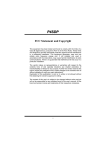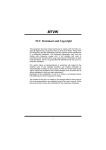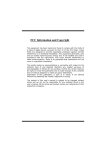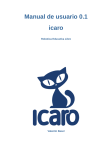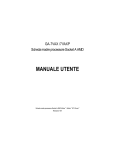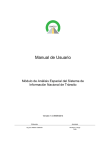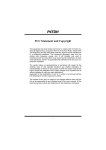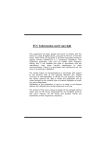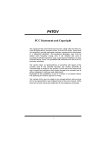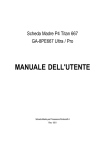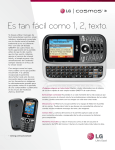Download Biostar P4TDK Owner's Manual
Transcript
P P44T TD DK K FCC Statement and Copyright This equipment has been tested and found to comply with the limits of a Class B digital device, pursuant to Part 15 of the FCC Rules. These limits are designed to provide reasonable protection against harmful interference in a residential installation. This equipment generates, uses and can radiate radio frequency energy and, if not installed and used in accordance with the instructions, may cause harmful interference to radio communications. There is no guarantee that interference will not occur in a particular installation. The vendor makes no representations or warranties with respect to the contents here of and specially disclaims any implied warranties of merchantability or fitness for any purpose. Further the vendor reserves the right to revise this publication and to make changes to the contents here of without obligation to notify any party beforehand. Duplication of this publication, in part or in whole is not allowed without first obtaining the vendor’s approval in writing. The content of this user’s is subject to be changed without notice and we will not be responsible for any mistakes found in this user’s manual. All the brand and product names are trademarks of their respective companies. i C Coonntteennttss ENGLISH..................................................................................................... 1 P4TDK Features .....................................................................................................1 Package contents ..................................................................................................1 Layout of P4TDK ....................................................................................................2 CPU Installation .....................................................................................................3 DDR DIMM Modules: DDR1-4 ................................................................................4 Jumpers, Headers, Connectors & Slots...............................................................5 SPANISH..................................................................................................... 9 Características del P4TDK ....................................................................................9 Contenido del Paquete ..........................................................................................9 Disposición del P4TDK........................................................................................10 Instalación de la CPU .......................................................................................... 11 Módulos DDR DIMM: DDR1-4..............................................................................12 Puentes, Cabezales, Conectores y Ranuras .....................................................13 TROUBLE SHOOTING............................................................................. 17 SOLUCIÓN DE PROBLEMAS ................................................................. 18 ii M Mootthheerrbbooaarrdd D Deessccrriippttiioonn English P4TDK Features Use Intel 82845E/ 82801DB Chipset, Winbond W83627HF, LAN Chip (optional), 1394 Chip (optional). Contains on board I/O facilities, which include two serial port, a parallel port, a PS/2 mouse port, a PS/2 keyboard port, audio ports, USB ports, a LAN port (optional) and a game port. Supports the Intel Pentium 4 (Socket 478) processor up to 2.4 GHz. Supports Ultra 100/66/33, BMIDE and PIO modes. Supports USB2.0 High Speed Device. Supports up to 2 GB for 4 single-sided or 2 Double sided DDR 200/266 MHz (with ECC) devices, running at 400/533 MHz Front Side Bus frequency. Supports AGP 2.0 interface, 2X/4X Fast write protocol. (1.5V Only) Complies with PC ATX form factor specifications. Supports popular operating systems such as Windows NT, Windows 2000, Windows ME, Windows XP, LINUX and SCO UNIX. ® Package contents HDD Cable X 1, FDD Cable X 1, Fully Setup Driver CD X 1 Flash Memory Writer for BIOS update X 1 USB Cable X 2 (Optional) Rear I/O Panel for ATX Case X 1 (Optional) 1 M Mootthheerrbbooaarrdd D Deessccrriippttiioonn Layout of P4TDK JKBMS1 K/B & Mouse JATXPWR2 JCFAN1 Socket 478 USB & LAN JRJ45USB1 JCOM1 DDR1 DDR3 DDR4 DDR2 DDR1 COM2 COM1 DDR2 Parallel Port COM1 JPRNT1 JAUXPWR1 USB INTEL 82845E GAME Port USB MIC-IN LINE-IN SP-OUT JCOM2 JGAME_USB1 AGP1 LAN CHIP JATXPWR1 PCI1 JDIMMVOLT JAUDIO1 BAT1 PCI2 IDE2 INTEL 82801DB (ICH4) JCDIN1 PCI3 JCDIN2 IDE1 PCI4 JTAD1 FDD1 JCMOS1 1394 CHIP PCI5 Winbond I/O JMS1 JSD1 PCI6 FWH BIOS CNR1 WOL1 2 JSC1 JSFAN1 JPANEL1 JUSB2 JUSB3 M Mootthheerrbbooaarrdd D Deessccrriippttiioonn CPU Installation CP U 1. Pull the lever sideways away from the socket then raise the lever up to 90-degree angle. 2. Locate Pin A in the socket and lock for the white dot or cut edge in the CPU. Match Pin A with the white dot/cut edge then insert the CPU. 3. Press the lever down. Then Put the fan on the CPU and buckle it and put the fan’s power port into the JCFAN1, then to complete the installation. CPU/ System Fan Headers: JCFAN1/ JSFAN1 12V Ground Sense 1 1 JCFAN1 Sense 12V Ground JSFAN1 3 M Mootthheerrbbooaarrdd D Deessccrriippttiioonn DDR DIMM Modules: DDR1-4 DRAM Access Time: 2.5V Unbuffered DDR 200/266 MHz Type required. DRAM Type: 128MB/ 256MB/ 512MB DIMM Module (184 pin) Due to the limitation of chipset, this board only can support up to 2 banks of DDR memory. However, in the market, there are so many single-sided modules occuping half bank. BIOSTAR would like to utilize the modules as many as possible. So we divide each bank into 2 sockets. That means any bank just can support one double-sided or two single-sided modules only. DDR1 & 2 => Bank 0, DDR3 & 4 => Bank 1. Each Bank 0 and 1, contain 2 DDR sockets, one white & one blue. Bank 0 Bank 1 ※ ※ ※ DDR1 DDR2 DDR3 DDR4 If you have one DDR module and you are not sure if it is a single or double- sided DDR module, please insert in DDR1 (blue color) socket first. If you have two DDR modules and you are not sure if they are single or double-sided DDR modules, please insert in DDR1 and 3 (blue color) Sockets. DDR 2 and 4, white color sockets, only support single-sided DDR module. ; For better compatibility, before insert DDR modules into the sockets, we strongly suggest to use the same type of modules including the model, speed and size of memory. 4 M Mootthheerrbbooaarrdd D Deessccrriippttiioonn Jumpers, Headers, Connectors & Slots Hard Disk Connectors: IDE1/ IDE2 The motherboard has a 32-bit Enhanced PCI IDE Controller that provides PIO Mode 0~4, Bus Master, and Ultra DMA / 33/ 66/ 100 functionality. It has two HDD connectors IDE1 (primary) and IDE2 (secondary). The IDE connectors can connect a master and a slave drive, so you can connect up to four hard disk drives. The first hard drive should always be connected to IDE1. Floppy Disk Connector: FDD1 The motherboard provides a standard floppy disk connector that supports 360K, 720K, 1.2M, 1.44M and 2.88M floppy disk types. This connector supports the provided floppy drive ribbon cables. Accelerated Graphics Port Slot: AGP1 Your monitor will attach directly to that video card. This motherboard supports video cards for PCI slots, but it is also equipped with an Accelerated Graphics Port (AGP). An AGP card will take advantage of AGP technology for improved video efficiency and performance, especially with 3D graphics. Communication Network Riser Slot: CNR1 The CNR specification is an open Industry Standard Architecture, and it defines a hardware scalable riser card interface, which supports audio, network and modem only. Peripheral Component Interconnect Slots: PCI1-6 This motherboard is equipped with 6 standard PCI slots. PCI stands for Peripheral Component Interconnect, and it is a bus standard for expansion cards, which has, supplanted the older ISA bus standard in most ports. This PCI slot is designated as 32 bits. 5 M Mootthheerrbbooaarrdd D Deessccrriippttiioonn Power Connectors: JATXPWR1/ JATXPWR2/ JAUXPWR1 JATXPWR2 JATXPWR1 JAUXPWR1 (ATX 12V Power Conn.) (ATX Main Power Conn.) (AUX Power Conn.) DIMM Power Selection Connector: JDIMMVOLT(Optional) 1 2 JDIMMVOLT (Default ==> 2.5V) Pin 1-2 on off ==> ==> Pin 3-4 on off ==> ==> Pin 5-6 on off ==> ==> Pin 7-8 on off ==> ==> 2.6V 2.6V 2.7V 2.7V 2.8V 2.8V 2.9V 2.9V * You can setup the DIMM Power in the BIOS Setup or JDIMMVOLT (one of them) for over voltage function. Wake On LAN Header: WOL1 Ground 5V_SB Wake up 1 WOL1 Front USB Header: JUSB2/ JUSB3(Optional) 2 1 JUSB2/3 Pin1,2 Pin3,4 Pin5,6 Pin7,8 Pin9 Pin10 6 ==> ==> ==> ==> ==> ==> +5V Data(-) Data(+) Ground KEY NA M Mootthheerrbbooaarrdd D Deessccrriippttiioonn Front Panel Connector: JPANEL1 1 2 SLP SPK PWR_LED HLED RST ON/OFF IR IR SPK ==> Speaker Conn. HLED ==> Hard Driver LED RST ==> Reset Button IR ==> Infrared Conn. SLP ==> Sleep Button PWR_LED ==> Power LED ON/ OFF ==> Power-on Button 23 24 Memory Stick Header: JMS1 (optional) 1 JMS1 Pin1 ==> Ground , Pin2 ==> MS1 Pin3 ==> 3.3V , Pin4 ==> MS2 Pin5 ==> MS3 , Pin6 ==> MS4 Pin7 ==> MS5 , Pin8 ==> MSCLK Pin9 ==> MSPWCTL# Pin10 ==> MSLED SD Memory Card Header: JSD1 (optional) 1 JSD1 Pin1 ==> Ground , Pin2 ==> SD1 Pin3 ==> 3.3V , Pin4 ==> SD2 Pin5 ==> SD3 , Pin6 ==> SD4 Pin7 ==> SD5 , Pin8 ==> SDCLK Pin9 ==> SDPWCTL# Pin10 ==> SDLED 7 M Mootthheerrbbooaarrdd D Deessccrriippttiioonn Smart Card Header: JSC1 (optional) 2 1 JSC1 Pin1 ==> 5V , Pin2 ==> Ground Pin3 ==> SCAPWRCTL# Pin4 ==> SCAR5# Pin5 ==> SCAC4 , Pin6 ==> SCALED Pin7 ==> SCAIO , Pin8 ==> SCAC8 Pin9 ==> SCACLK Pin10 ==> SCAPSNT Audio Subsystem: JAUDIO1/ JTAD1(Optional)/ JCDIN1/ JCDIN2(Optional) 2 1 1 JAUDIO1 (Front Audio Header) JTAD1 => optional (Telephony Audio Header) 1 1 JCDIN2 => optional (CD-ROM Audio-In Header) JCDIN1 (CD-ROM Audio-In Header) Back Panel Connectors JGAME1_USB1 JKBMS1 RJ45USB1 JPRNT1 PS/2 LAN(Optional) Mouse PS/2 Keyboard USB Game Port/ USB Ports (optional) Parallel COM1 VGA1 JCOM1 JVGA1 8 Speaker Line In Mic Out In M Mootthheerrbbooaarrdd D Deessccrriippttiioonn Spanish Características del P4TDK Usa Chipset Intel 82845E/ 82801DB, Winbond W83627HF, Chip LAN (opcional), Chip 1394 (opcional). Contiene facilidades I/O integrados en la placa madre en el que incluye dos puertos en series, un puerto paralelo, un puerto para ratón PS/2, un puerto para teclado PS/2, puertos de audio, puertos USB, puerto LAN (opcional) y un puerto para juego. Soporta procesador Intel Pentium 4 (Socket 478) de hasta 2.4 GHz. Soporta Ultra 100/66/33, BMIDE y modos PIO. Soporta USB2.0 Dispositivo de Alta Velocidad. Soporta hasta 2 GB para dispositivos de 4 single-sided o 2 Double sided DDR 200/266 MHz (sin ECC), corriendo a 400/533 MHz frecuencia del Front Side Bus. Soporta interface AGP 2.0, 2X/4X Fast write protocol. (Solamente 1.5V) Compatible con el factor de forma PC ATX. Soporta sistemas operativos populares tales como Windows NT, Windows 2000, Windows ME, Windows XP, LINUX y SCO UNIX. ® Contenido del Paquete Cable HDD X 1, Cable FDD X 1, Configuración completa del Driver CD X 1 Flash Memory Writer para actualización del BIOS X 1 Cable USB X 2 (Opcional) Panel Trasero I/O para caja ATX X 1 (Opcional) 9 M Mootthheerrbbooaarrdd D Deessccrriippttiioonn Disposición del P4TDK JKBMS1 K/B & Mouse JATXPWR2 JCFAN1 Socket 478 USB & LAN JRJ45USB1 JCOM1 DDR1 DDR3 DDR4 DDR2 DDR1 COM2 COM1 DDR2 Parallel Port COM1 JPRNT1 JAUXPWR1 USB INTEL 82845E GAME Port USB MIC-IN LINE-IN SP-OUT JCOM2 JGAME_USB1 AGP1 LAN CHIP JATXPWR1 PCI1 JDIMMVOLT JAUDIO1 BAT1 PCI2 IDE2 INTEL 82801DB (ICH4) JCDIN1 PCI3 JCDIN2 IDE1 PCI4 JTAD1 FDD1 JCMOS1 1394 CHIP PCI5 Winbond I/O JMS1 JSD1 PCI6 FWH BIOS CNR1 WOL1 10 JSC1 JSFAN1 JPANEL1 JUSB2 JUSB3 M Mootthheerrbbooaarrdd D Deessccrriippttiioonn Instalación de la CPU CP U 1. Tire de la palanca del lado del zócalo, luego levante la palanca hasta un ángulo de 90 grados. 2. Sitúe el contacto A del zócalo y busque el punto blanco o corte el borde en la CPU. Empareje el contacto A con el punto blanco/ corte del borde, luego inserte la CPU. 3. Presione la palanca hacia abajo. Ponga el ventilador en la CPU y abróchelo. Luego ponga el puerto de corriente del ventilador en el JCFAN1. Y ya habrá completado su instalación. CPU/ Cabezales del Sistema de Ventilación: JCFAN1/ JSFAN1 12V Tierra Sense 1 1 JCFAN1 Sense 12V Tierra JSFAN1 11 M Mootthheerrbbooaarrdd D Deessccrriippttiioonn Módulos DDR DIMM: DDR1-4 DRAM Tiempo de Acceso: 2.5V Unbuffered DDR 200/266 MHz Tipo requerido. DRAM Tipo: 128MB/ 256MB/ 512MB Módulo DIMM (184 contactos) Debido a la limitación del chipset, éste tablero puede apoyar solamente hasta 2 bancos de memoria DDR. Sin embargo, en el mercado hay muchos módulos single-sided ocupando el banco medio. BIOSTAR desearía utilizar los módulos tantos como sea posible. Debido a ésto, hemos dividido a cada banco en 2 zócalos. Ésto quiere decir que cualquier banco solamente puede apoyar un modulo double-sided o dos modulos single-sided. DDR1 y 2 => Banco 0, DDR3 y 4 => Banco 1. Cada Banco 0 y 1, contiene 2 zócalos DDR, uno blanco y uno azul. Banco 0 Banco 1 ※ ※ ※ DDR1 DDR2 DDR3 DDR4 Si usted tiene un modulo DDR y no está seguro si el modulo DDR es single o double- sided, por favor inserte en el zócalo DDR1 (color azul) primeramente. Si usted tiene dos módulos DDR y no está seguro si los módulos DDR son single o double-sided, por favor inserte en los zócalos DDR1 y 3 (color azul). DDR 2 y 4, zócalos de color blanco, solamente soporta soporta módulos DDR single-sided. ; Para mejor compatibilidad, antes de insertar el módulo DDR en los zócalos, es fuertemente recomendado usar el mismo tipo de módulos incluyendo el modelo, la velocidad y el tamaño de memoria. 12 M Mootthheerrbbooaarrdd D Deessccrriippttiioonn Puentes, Cabezales, Conectores y Ranuras Conectores del Disco Duro: IDE1/ IDE2 La placa madre tiene un controlador de 32-bit PCI IDE que proporciona Modo PIO 0~4, Bus Master, y funcionalidad Ultra DMA / 33/ 66/ 100. Tiene dos conectores HDD IDE1 (primario) y IDE2 (secundario). Los conectores IDE pueden conectarse a un master y a un esclavo drive para así conectar hasta cuatro discos duros. El primer disco duro debe estar siempre conectado al IDE1. Conector para Disquete: FDD1 La placa madre proporciona un conector estándar del disquete que suporta 360K, 720K, 1.2M, 1.44M y 2.88M tipos de disquete. Éste conector apoya los cables de cinta proporcionados por el disquete. Ranura del Puerto Acelerado para Gráficos: AGP1 Su monitor se fijará directamente a ésta tarjeta de video. Ésta placa madre soporta tarjeta de video para ranuras PCI, pero también está equipado con un Puerto Acelerado para Gráficos (AGP). La tarjeta AGP tomará ventaja de la tecnología AGP para mejorar la eficacia y funcionamiento del video, especialmente con gráficos 3D. Ranura de Banda de Suspensión de Comunicación y Red: CNR1 La especificación CNR es una abierta Industria Estándar de Arquitectura, y define una tarjeta de interface escalable del hardware en el que soporta, audio, network y módem. Ranuras de Interconexión del Componente Periférico: PCI1-6 Ésta placa madre está equipado con 6 ranuras estándar PCI. PCI es la sigla para Interconexión del Componente Periférico, y es una tarjeta de expansión bus estándar en el que suplanta a la antigua ISA bus estándar en sus mayorias de las partes. Ésta ranura PCI está diseñado con 32 bits. 13 M Mootthheerrbbooaarrdd D Deessccrriippttiioonn Conectores de Corriente: JATXPWR1/ JATXPWR2/ JAUXPWR1 JATXPWR2 JATXPWR1 JAUXPWR1 (ATX 12V Conector de Corriente.) (ATX Conector de Corriente Principal.) (AUX Conector de Corriente.) Conector de Selección de la Corriente DIMM: JDIMMVOLT(Opcional) 1 2 JDIMMVOLT (Default ==> 2.5V) Contacto Pin 1-2 off1-2 ==> encendido 2.6V ==> Pin 3-4 off3-4 Contacto ==> encendido 2.7V ==> Pin 5-6 off5-6 Contacto ==> encendido 2.8V ==> Pin 7-8 off7-8 Contacto ==> encendido 2.9V ==> 2.6V 2.7V 2.8V 2.9V * Usted puede configurar la corriente DIMM en la Configuración del BIOS o JDIMMVOLT (uno de ellos) para el funcionamiento del sobre voltaje. Cabezal Wake On LAN: WOL1 Tierra 5V_SB Wake up 1 WOL1 Cabezal Frontal USB: JUSB2/ JUSB3(Opcional) 2 1 JUSB2/3 Contacto1,2 Contacto3,4 Contacto5,6 Contacto7,8 Contacto9 Contacto10 14 ==> ==> ==> ==> ==> ==> +5V Dato(-) Dato(+) Tierra KEY NA M Mootthheerrbbooaarrdd D Deessccrriippttiioonn Conector del Panel Frontal: JPANEL1 1 2 SLP SPK PWR_LED HLED RST ON/OFF IR IR SPK ==> Conector del Altavoz HLED ==> LED del Disco Duro RST ==> Boton de Reinicio IR ==> Conexion Infrarojo SLP ==> Boton de Suspension PWR_LED ==> Corriente LED ON/ OFF ==> Boton de Encendido 23 24 Cabezal Memory Stick: JMS1 (opcional) 1 JMS1 Contacto1 ==> Tierra , Contacto2 ==> MS1 Contacto3 ==> 3.3V , Contacto4 ==> MS2 Contacto5 ==> MS3 , Contacto6 ==> MS4 Contacto7 ==> MS5 , Contacto8 ==> MSCLK Contacto9 ==> MSPWCTL# Contacto10 ==> MSLED Cabezal SD Memory Card: JSD1 (opcional) 1 JSD1 Contacto1 ==> Tierra , Contacto2 ==> SD1 Contacto3 ==> 3.3V , Contacto4 ==> SD2 Contacto5 ==> SD3 , Contacto6 ==> SD4 Contacto7 ==> SD5 , Contacto8 ==> SDCLK Contacto9 ==> SDPWCTL# Contacto10 ==> SDLED 15 M Mootthheerrbbooaarrdd D Deessccrriippttiioonn Cabezal Smart Card: JSC1 (opcional) Contacto1 ==> 5V , Contacto2 ==> Tierra Contacto3 ==> SCAPWRCTL# Contacto4 ==> SCAR5# Contacto5 ==> SCAC4 , Contacto6 ==> SCALED Contacto7 ==> SCAIO , Contacto8 ==> SCAC8 Contacto9 ==> SCACLK Contacto10 ==> SCAPSNT 2 1 JSC1 Subsistema de Audio: JAUDIO1/ JTAD1(Opcional)/ JCDIN1/ JCDIN2(Opcional) 2 1 1 JAUDIO1 (Cabezal de Audio Frontal) JTAD1 => opcional (Cabezal de Audio Telefonico) 1 1 JCDIN2 => opcional JCDIN1 (Cabezal de Entrada de Audio CD-ROM) (Cabezal de Entrada de Audio CD-ROM) Conectores del Panel Trasero JGAME1_USB1 JKBMS1 RJ45USB1 Raton PS/2 Teclado PS/2 Game Port/ USB Ports (optional) JPRNT1 LAN(Opcional) Paralelo USB COM1 COM2 JCOM1 JCOM2 (Puertos en Serie) 16 Entrada de Linea Entrada del Mic Salida del Altavoz Trouble Shooting PROBABLE SOLUTION No power to the system at all Power light don’t * Make sure power cable is securely plugged in illuminate, fan inside power supply does not turn * Replace cable on. Indicator light on keyboard does not turn on * Contact technical support PROBABLE SOLUTION System inoperative. Keyboard lights are on, * Using even pressure on both ends of the power indicator lights are lit, hard drive is DIMM, press down firmly until the module snaps into place. spinning. PROBABLE SOLUTION System does not boot from hard disk drive, can * Check cable running from disk to disk be booted from CD-ROM drive. controller board. Make sure both ends are securely plugged in; check the drive type in the standard CMOS setup. * Backing up the hard drive is extremely important. All hard disks are capable of breaking down at any time. PROBABLE SOLUTION System only boots from CD-ROM. Hard disk can * Back up data and applications files. Reformat be read and applications can be used but the hard drive. Re-install applications and data using backup disks. booting from hard disk is impossible. PROBABLE SOLUTION Screen message says “Invalid Configuration” or * Review system’s equipment . Make sure “CMOS Failure.” correct information is in setup. PROBABLE SOLUTION Cannot boot system after installing second hard * Set master/slave jumpers correctly. drive. * Run SETUP program and select correct drive types. Call drive manufacturers for compatibility with other drives. 17 Solución de Problemas CAUSA PROBABLE SOLUCIÓN No hay corriente en el sistema. La luz de * Asegúrese que el cable de transmisión esté corriente no ilumina, ventilador dentro de la seguramente enchufado. fuente de alimentación apagada. Indicador de * Reemplace el cable. luz del teclado apagado. * Contacte ayuda técnica. CAUSA PROBABLE SOLUCIÓN Sistema inoperativo. Luz del teclado encendido, * Presione los dos extremos del DIMM, presione luz de indicador de corriente iluminado, disco para abajo firmemente hasta que el módulo encaje en el lugar. rígido está girando. CAUSA PROBABLE SOLUCIÓN Sistema no arranca desde el disco rígido, puede * Controle el cable de ejecución desde el disco ser arrancado desde el CD-ROM drive. hasta el disco del controlador. Asegúrese de que ambos lados estén enchufados con seguridad; controle el tipo de disco en la configuración estándar CMOS. * Copiando el disco rígido es extremadamente importante. Todos los discos rígidos son capaces de dañarse en cualquier momento. CAUSA PROBABLE SOLUCIÓN Sistema solamente arranca desde el CD-ROM. * Copie datos y documentos de aplicación. Disco rígido puede leer y aplicaciones pueden Vuelva a formatear el disco rígido. Vuelva a ser usados pero el arranque desde el disco instalar las aplicaciones y datos usando el disco de copiado. rígido es imposible. CAUSA PROBABLE SOLUCIÓN Mensaje de pantalla ”Invalid Configuration” o * Revise el equipo del sistema. Asegúrese de “CMOS Failure.” que la información configurada sea correcta. CAUSA PROBABLE SOLUCIÓN No puede arrancar después de instalar el * Fije correctamente el puente master/esclavo. segundo disco rígido. * Ejecute el programa SETUP y seleccione el tipo de disco correcto. Llame a una manufacturación del disco para compatibilidad con otros discos. 18 04/30/2002 19
This document in other languages
- español: Biostar P4TDK

























